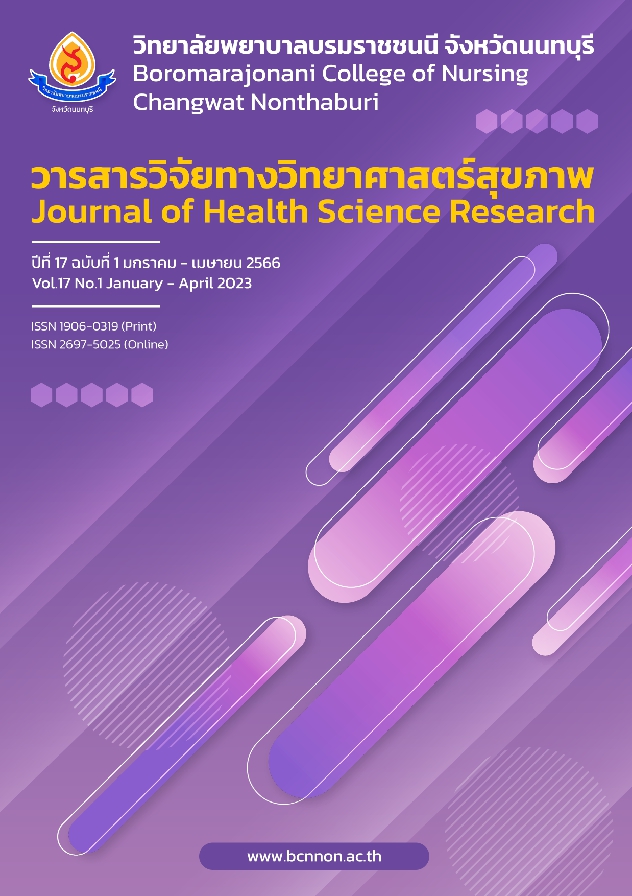ประสิทธิผลของโปรแกรมส่งเสริมความฉลาดทางดิจิทัลต่อพฤติกรรมการป้องกันการถูกระรานและการป้องกันการระรานผู้อื่นทางโลกออนไลน์ของนักเรียนชั้นมัธยมศึกษาตอนต้น จังหวัดนนทบุรี
Main Article Content
บทคัดย่อ
บทนำ : เยาวชนเข้าถึงสื่อดิจิทัลได้ง่ายและใช้ในทางที่ไม่ถูกต้อง ซึ่งเป็นสาเหตุในการระรานทางโลกออนไลน์ ที่ส่งผลกระทบต่อสุขภาพจิตและปัญหาการฆ่าตัวตาย การส่งเสริมความฉลาดทางดิจิทัลเป็นวิธีการหนึ่งที่ช่วยเพิ่มพฤติกรรมการป้องกันการถูกระรานและการป้องกันการระรานผู้อื่นทางโลกออนไลน์
วัตถุประสงค์การวิจัย : ศึกษาประสิทธิผลของโปรแกรมส่งเสริมความฉลาดทางดิจิทัลต่อพฤติกรรมการป้องกันการถูกระรานและการป้องกันการระรานผู้อื่นทางโลกออนไลน์ของนักเรียนชั้นมัธยมศึกษาตอนต้น จังหวัดนนทบุรี
วิธีการวิจัย : เป็นการวิจัยกึ่งทดลอง กลุ่มตัวอย่างเป็นนักเรียนชั้นมัธยมศึกษาตอนต้น จังหวัดนนทบุรี อายุ 13-15 ปี แบ่งกลุ่มเป็น 2 กลุ่ม คือ กลุ่มทดลอง จำนวน 40 คน และกลุ่มควบคุม จำนวน 38 คน กลุ่มทดลองได้รับโปรแกรมส่งเสริมความฉลาดทางดิจิทัล จำนวน 5 สัปดาห์ ๆ ละ 1 ครั้ง ๆ ละ 50 นาที ส่วนกลุ่มควบคุมได้รับใบความรู้ในการป้องกันการถูกระรานและการป้องกันการระรานผู้อื่นทางโลกออนไลน์ เครื่องมือที่ใช้เก็บข้อมูล ได้แก่ แบบประเมินพฤติกรรมการป้องกันการถูกระรานและแบบประเมินพฤติกรรมการป้องกันการระรานผู้อื่นทางโลกออนไลน์ วิเคราะห์ข้อมูลด้วยสถิติเชิงพรรณนา และสถิติทดสอบค่าที
ผลการวิจัย : หลังได้รับโปรแกรมฯ กลุ่มทดลองมีคะแนนเฉลี่ยพฤติกรรมการป้องกันการถูกระรานและพฤติกรรมการป้องกันการระรานผู้อื่นทางโลกออนไลน์สูงกว่ากลุ่มควบคุมอย่างมีนัยสำคัญทางสถิติ (p<.05)
สรุปผล : โปรแกรมฯ สามารถทำให้เกิดพฤติกรรมการป้องกันการถูกระรานและพฤติกรรมการป้องกันการระรานผู้อื่นทางโลกออนไลน์ได้ บุคลากรด้านการศึกษาหรือสาธารณสุขสามารถประยุกต์กิจกรรมในโปรแกรมฯ ไปใช้เป็นแนวปฏิบัติในกลุ่มนักเรียนมัธยมศึกษาตอนต้นต่อไป
Downloads
Article Details

อนุญาตภายใต้เงื่อนไข Creative Commons Attribution-NonCommercial-NoDerivatives 4.0 International License.
บทความที่ได้รับการตีพิมพ์เป็นลิขสิทธิ์ของวิทยาลัยพยาบาลบรมราชชนนี จังหวัดนนทบุรี
ข้อความที่ปรากฏในบทความแต่ละเรื่องในวารสารวิชาการเล่มนี้เป็นความคิดเห็นส่วนตัวของผู้เขียนแต่ละท่านไม่เกี่ยวข้องกับวิทยาลัยพยาบาลบรมราชชนนี จังหวัดนนทบุรี และคณาจารย์ท่านอื่น ในวิทยาลัยฯ แต่อย่างใด ความรับผิดชอบองค์ประกอบทั้งหมดของบทความแต่ละเรื่องเป็นของผู้เขียนแต่ละท่าน หากมีความผิดพลาดใด ๆ ผู้เขียนแต่ละท่านจะรับผิดชอบบทความของตนเองแต่ผู้เดียว
เอกสารอ้างอิง
Inthanon S. Cyberbullying. (3rd ed.). Pathumthani: Walk on Cloud Company Limittd; 2020. (in Thai).
Thai Health Promotion Foundation. Thai Health Watch 2020. Bangkok: Wisesight (Thailand) Company Limited; 2019. (in Thai).
Matichon online. Because it is 'the child is (not) in pain' opens the door to understanding, and dealing with 'cyberbullying'.31 Mar 2021. [internet]. 2021 [cited 2022 Nov 1]; Available from: https://www.matichon.co.th/ lifestyle/social-women/news_2650636. (in Thai).
Pornnoppadon C. Open research on cyberbullying thai youth and risks in the 4.0. [internet]. 2018 [cited 2022 Nov 25]; Available from: https://www.prachachat. net/ict/news-146408. (in Thai).
Digital Economy Promotion Agency. Online behavior survey Thai children are at risk of 4 types of threats. [internet]. 2018 [cited 2022 Nov 1]; Available from: https://www. depa.or.th/th/article-view/4. (in Thai).
Department of Mental Health. Thailand's children bully each other, ranking second in the world. [internet]. 2018 [cited 2022 Nov 1]; Available from: https://www.dmh. go.th/news-dmh/view.asp?id=27488.(in Thai).
Inthanon S. DQ: digital intelligence. (1rd st.). Pathumthani: Child and Youth Media Institute; 2020. (in Thai).
Jantapaso S, Sirawong N, Sriarunrasmee J. An application development for the cyberbullying awareness of Mattayomsuksa 1 students. Journal of Industrial Education. 2020;14(1):56-69. (in Thai).
Butsri P, Wongwanich Rumpagaporn M, Khemtong P. Learning activities with storyline
technique on contemplative education concept to enhance digital literacy in topic “cyberbullying” in mathayomsuksa III students in mathayomprachaniwet school, bangkok, in academic year 2019. Kasetsart Education Review. 2020;35(3):154-66. (in Thai).
Kuankaew W, Phongkhunakorn N, Robkob W. The development of learning innovation for cyberbullying prevention and cyberbullying victimization among Thai Youth. Journal of Nursing and Health Research. 2021;22(2):28-40. (in Thai).
Faul F, Erdfelder E, Lang AG, Buchner A. G*Power 3: A flexible statistical power analysis program for the social, behavioral, and biomedical sciences. Behav Res Methods. 2007;39(2):175-91. doi: 10.3758/bf03193146.
Anuroj K. Pityaratstian N. Validity and reliability of cyber-aggression perpetration and victimization scale: Thai Version. Journal of the Psychiatric Association of Thailand. 2019;64(1):45-60. (in Thai).
Roopleam T. Development of digital intelligence quotient program for elementary school students. [internet]. 2017 [cited 2022 Nov 25]; Available from: http://202.28.34.124/dspace/bitstream/123456789/353/1/59010584003.pdf.(in Thai).
Pasunon P. Reliability of questionnaire in quantitative research. Parichart Journal. 2014;27(1):144-63. (in Thai).
Bonwell C. Active learning: Creating excitement in the classroom. Washington DC: School of Education and Human Development, George Washington University; 1991.
Pruetthikun S. Teaching and learning through active learning. [internet]. 2016 [cited 2022 Nov 25]; Available from: https://km.buu.ac.th/article/frontend/article_detail/141. (in Thai).
Tudkuea T, Laeheem K, Sittichai R. Guidelines for preventive cyber bullying behaviors among secondary school students in the three southern border provinces. Journal of Behavioral Science for Development. 2019;11(1):91-106. (in Thai).
Chanasak S, Saengpanya W. Problem-based learning to develop empathy in cyberbullying of sixth grade students. An Online Journal of Education. 2019;14(2):1-11. (in Thai).


